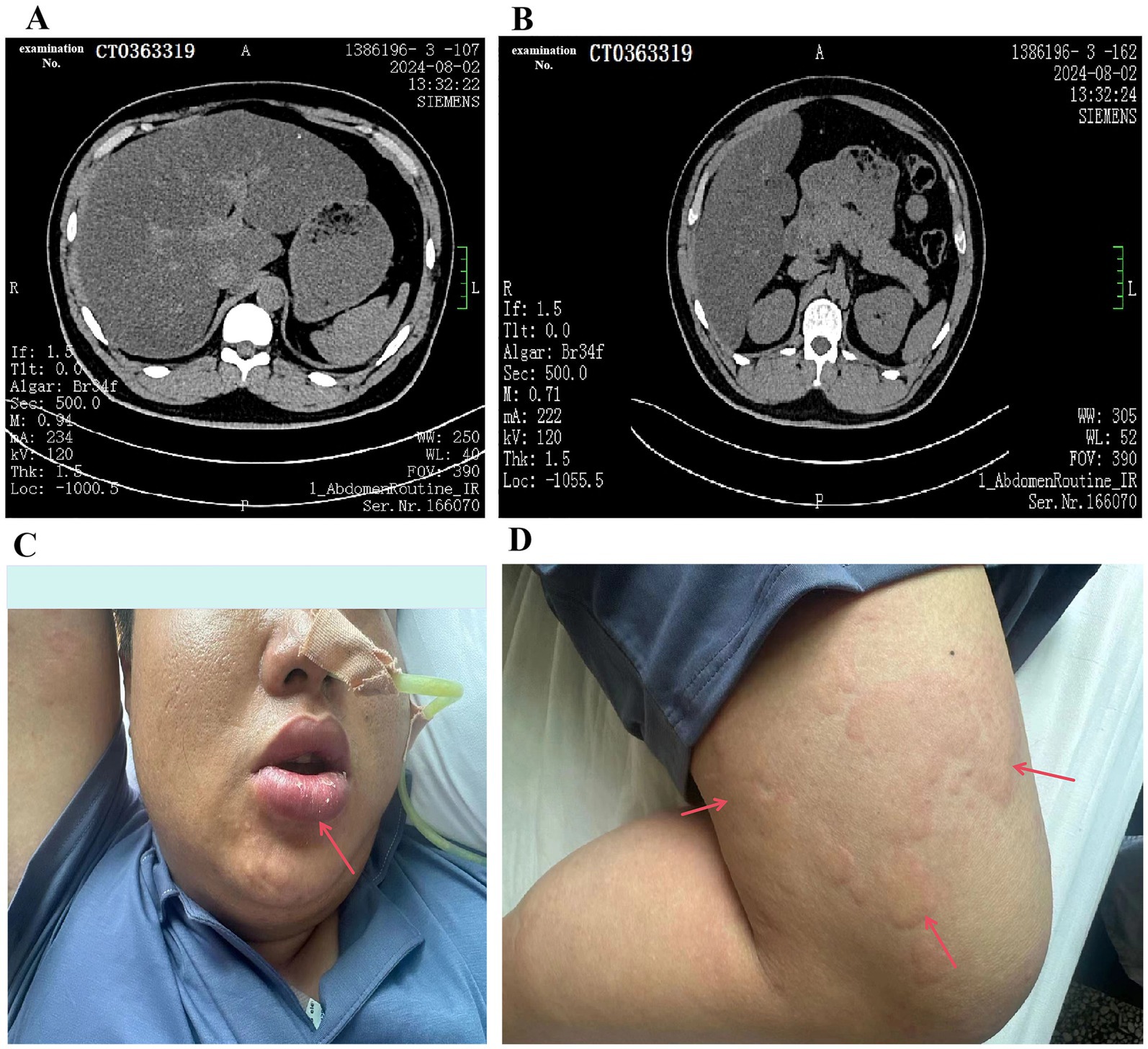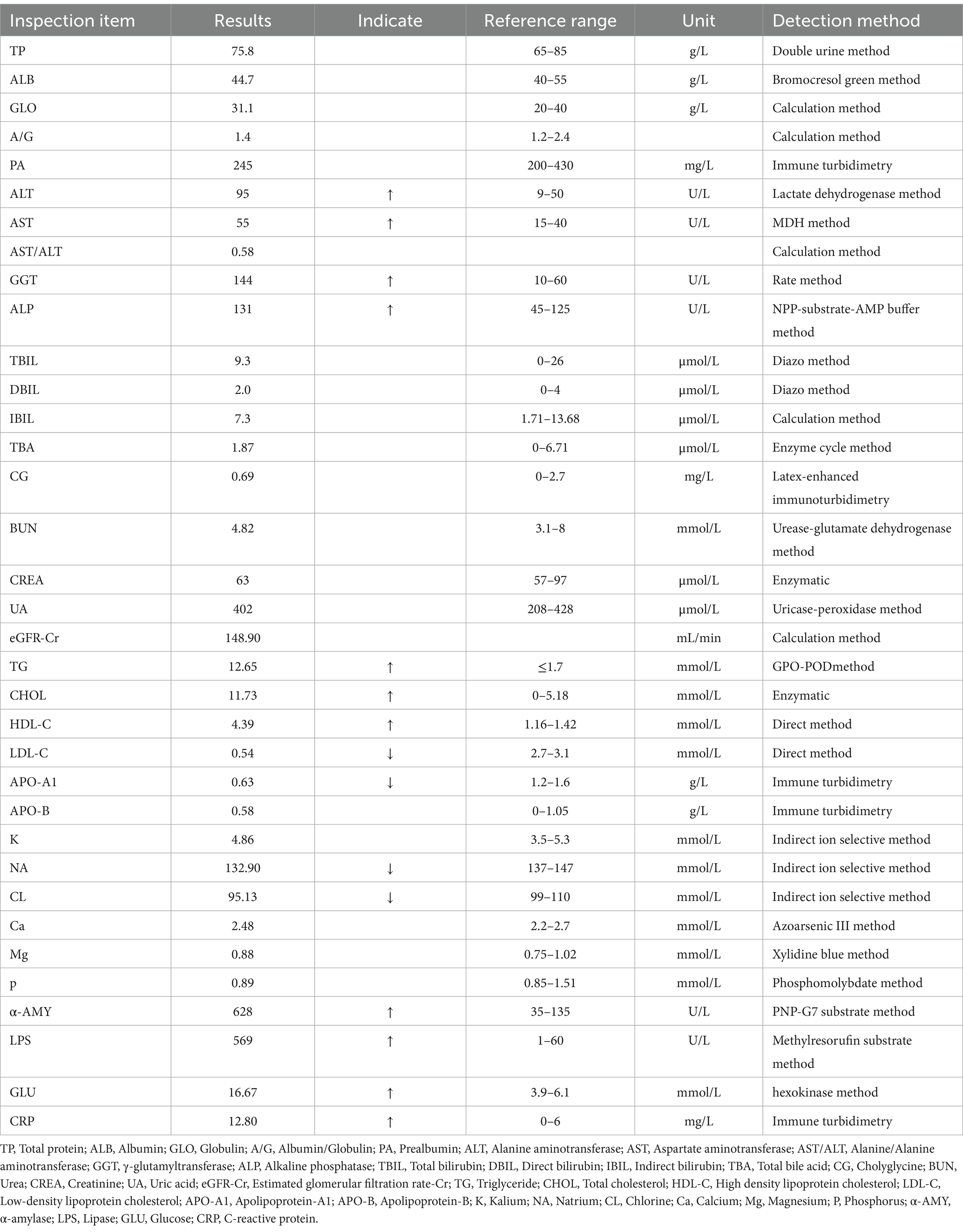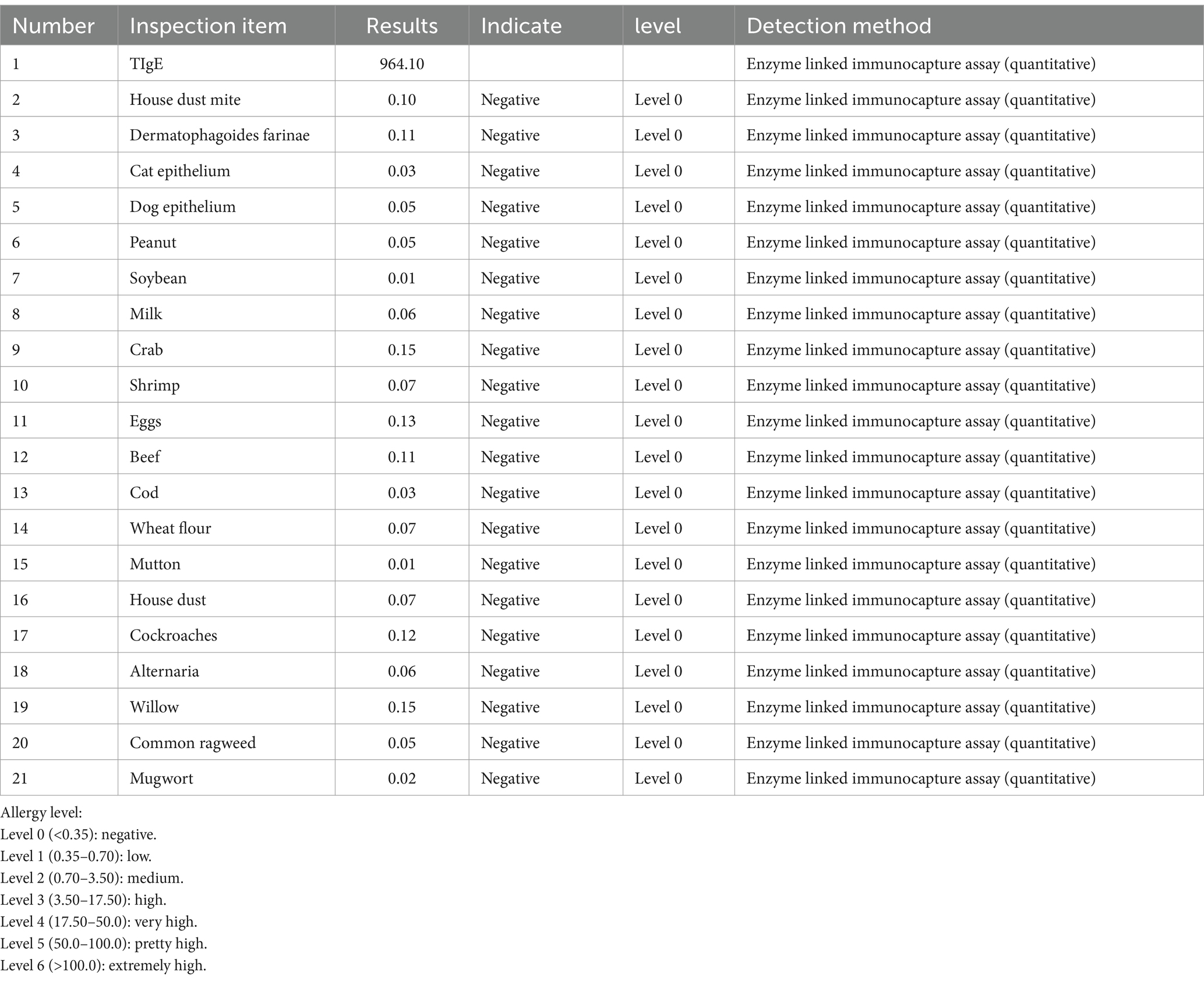- 1Department of Science Research, Zhejiang Provincial People’s Hospital Bijie Hospital, Bijie, China
- 2Department of Gastroenterology, Zhejiang Provincial People’s Hospital Bijie Hospital, Bijie, China
- 3Department of Medical Laboratory, Zhejiang Provincial People’s Hospital Bijie Hospital, Bijie, China
This study mainly reports a case of a middle-aged man who was admitted to the hospital due to sudden upper abdominal pain after several hours. After being given the painkiller compound diclofenac sodium in the outpatient clinic, the patient suffered from systemic itching, redness, and rash. Acute pancreatitis was diagnosed after admission. During the treatment, the patient had allergic reactions to multiple drugs. This case is rare. In this case, case reports are used for improving the understanding of multi-drug allergies by clinical pharmacists and clinicians, which offers certain reference for dealing with the safety and effectiveness of medication in patients undergoing multi-drug allergies.
1 Introduction
Acute pancreatitis frequently occurs in adults. It is an inflammatory disease of the pancreas tissue’s own digestive system caused by abnormal activation of pancreatic enzymes. It is the main reason for admission to hospital because of gastrointestinal diseases in most patients and may result in multiple organ dysfunction (1). Medical treatment for acute pancreatitis includes supplementation of large amounts of fluids, proton pump inhibitors, somatostatin, and intravenous infusions including prophylactic use of antibiotics (2). In cases where there is a lot of pancreatic tissue necrosis, non-drug treatment can be applied, that is, minimally invasive pancreatic surgery can be performed to remove the necrotic lesion to prevent lesion expansion and exacerbation of the condition.
Multi-drug allergy refers to the patient’s allergic reaction to multiple drugs with different chemical structures at the same time (3). Drug treatment has been the most significant treatment method for the treatment of acute pancreatitis. However, some patients experience allergic reactions to multiple drugs. Therefore, discovering and solving the drug safety of this type of patient has become an urgent problem to be addressed at present. This article reports a case of acute pancreatitis who had allergic reactions to multiple drugs during admission to the hospital for medical treatment, providing certain references for clinicians.
2 Case report
The 32-year-old male patient was admitted to our hospital on August 2, 2024 due to unexplained upper abdominal pain for 5 h, accompanied by nausea and non-jet vomiting. There was no drag pain or metastatic pain. Physical examination revealed that the patient was tender throughout the body, with obvious abdominal bulge, obvious tenderness under the xiphoid process and left upper abdomen, and no percussion pain in both kidney areas. No hematemesis, melena, chest tightness, chest pain, frequent urination, urgency or disturbance of consciousness was observed. Owing to the unbearable pain, 2 mL compound diclofenac sodium (containing diclofenac sodium 25 mg and acetaminophen 150 mg) was given through intramuscular injection at the outpatient department. After a few minutes, the patient developed erythema all over the body without itching and discomfort. Meanwhile, an allergic reaction was taken into consideration. After giving 1 mL diphenhydramine hydrochloride (1 mL:20 mg) via intramuscular injection for anti-allergic treatment, the symptoms disappeared. It was initially considered that the patient was admitted to the Department of Gastroenterology of our hospital for acute pancreatitis. After admission, the blood sugar was randomly 16.67 mmol/L with the glycosylated hemoglobin being 9.6%. Considering that the patient may have diabetes, 20 IU insulin (10 mL:400 IU) was given to control blood sugar. On August 2, 2024, laboratory test results demonstrated that triglycerides (12.65 mmol/L), high-density lipoprotein cholesterol (4.39 mmol/L), C-reactive protein (12.80 mg/L), lipase (569 U/L), γ-glutamyltransferase (144 U/L), alanine aminotransferase (95 U/L), aspartate aminotransferase (55 U/L), total cholesterol (11.73 mmol/L), α-amylase (628 U/L) and glucose (16.67 mmol/L) were all elevated (Table 1). Medical imaging data and image examination results during CT upper abdominal plain scan revealed signs of fatty liver (Figure 1A) and slightly indistinct margins of the pancreatic head (Figure 1B).

Figure 1. (A) A computerized tomography image of the patient’s liver with acute pancreatitis. (B) A computerized tomography image of the patient’s pancreas with acute pancreatitis. (C,D) Allergic reaction in a patient with acute pancreatitis after drug infusion.
The above results showed that the patient had hyperlipidemia pancreatitis. Therefore, the patient was given oral bezafibrate tablets (0.4 g) three times a day to lower blood lipids. Firstly, ceftriaxone sodium for injection (2.0 g) combined with levofloxacin injection (100 mL: 0.5 g) was administered empirically once daily for anti-infective treatment. During the infusion of ceftriaxone, the patient developed mild rash and itching symptoms. The symptoms improved after the infusion of ceftriaxone was stopped. Therefore, the patient was considered to be allergic to ceftriaxone. Secondly, somatostatin (3 mg) was injected intravenously every 12 h, aiming to inhibit pancreatic secretion. Then, gabexate mesylate (0.1 g) was injected intravenously every 8 h to inhibit pancreatic enzyme activity. Next, 100 mL raw rhubarb water was injected into gastric tube three times a day for enema to relieve constipation. Local exudation was reduced by the external application of mirabilite to the abdomen. To relieve pain, phloroglucinol (80 mg) injection was given once. Symptomatic and supportive treatments including potassium supplementation and fluid replacement were used to maintain electrolyte balance. After infusion of gabexate mesylate, the patient developed systemic wheals, and rash, accompanied by itching, and swollen lips (Figures 1C,D). Gabexate mesylate was immediately stopped, and 1 mL diphenhydramine (1 mL:20 mg) was given for anti-allergic treatment. After anti-allergic treatment, the patient’s rash and itching were significantly improved. Therefore, it was considered that the patient was allergic to gabexate mesylate. Given that the patient was allergic to gabexate mesylate, ulinastatin (100,000 U) was used to inhibit the activities of pancreatic enzymes. While ulinastatin was infused, the patient also developed allergic symptoms such as rash and itching. Ulinastatin was immediately stopped, and the allergic symptoms were significantly improved. Therefore, it was considered that the patient was also allergic to ulinastatin.
To sum up, the patient was allergic to ceftriaxone, gabexate mesylate, and ulinastatin. Upon inquiry, the patient stated that he had experienced redness, rash, and itching all over the body after taking painkillers (the painkiller is a compound preparation composed of acetaminophen, caffeine and aspirin) for cold, fever and headache. In addition, the patient reported that after taking ankahuangmin capsules (ankahuangmin capsule is a compound preparation composed of acetaminophen, caffeine, artificial bezoar, and chlorpheniramine maleate). The next day, he also exhibited similar symptoms. Moreover, these symptoms disappeared after stopping using these drugs. Considering that the patient was allergic to the painkillers and ankahuangmin capsules, the patient also showed that the skin would become red and swollen after using topical flurbiprofen cataplasms. In addition, the symptoms eased after stopping the drug. Therefore, it was considered that the patient was allergic to Flurbiprofen Cataplasms. On August 6, 2024, the patient was subjected to quantitative screening for autoimmune antibodies, inhalation allergens, and food allergens, and the results indicated no significant abnormalities (Table 2).
3 Discussion
In the United States and even most countries, acute pancreatitis exhibits a high incidence and is one of the primary causes of hospitalizations for gastrointestinal diseases (4). Recently, the incidence of acute pancreatitis in China is approximately (13–45)/100,000 people. The incidence rate in men is significantly higher than that in women. With the increase of age, the incidence and mortality rate are increasing, accordingly. Currently, the number of patients with acute pancreatitis admitted to the Department of Gastroenterology in our hospital is also on the rise year by year. China is confronting the risk of population aging, and thus the treatment of patients with pancreatitis is also a major challenge at present. There are many pathogeneses involved in acute pancreatitis. Among them, stone obstruction of the common bile duct, alcohol abuse, and hyperlipidemia are considered the most common causes of acute pancreatitis (5, 6). It has been reported that alcohol and smoking cessation can lower the risk of progression of pancreatitis and reduce its recurrence (7). Because the clinical manifestations of acute pancreatitis are complex, its clinical manifestations are easily confused with other acute abdominal diseases. In atypical cases, the diseases that clinicians need to distinguish and diagnose include acute cholecystitis and cholelithiasis (the abdominal pain of acute cholecystitis is milder than that of acute pancreatitis, the pain is located in the gallbladder area of the upper right abdomen, radiating to the right chest and the right shoulder, with the normal or slightly higher hematuria amylase; if accompanied by biliary stones, the abdominal pain is more severe, and is frequently accompanied by chills, high fever and jaundice). Perforation of gastric and duodenal ulcer (perforation of ulcer disease is sudden severe pain in the upper abdomen quickly spreading to the whole abdomen), coronary heart disease or myocardial infarction (in acute pancreatitis, abdominal pain may be reflexively radiated to the precordial area or produce a variety of electrocardiogram changes, which are often confused. However, patients suffering from coronary heart disease may have a history of coronary heart disease, a sense of pressure in the chest area, and insignificant abdominal signs, which must be carefully identified) and digestive tract tumors. Gabexate mesylate is a drug which can be mainly used for the basic treatment of acute pancreatitis in clinical practice (8). To relieve the symptoms of a patient with acute pancreatitis, the analgesic compound diclofenac sodium, the trypsin inhibitor gabexate mesylate, and the anti-infective drug ceftriaxone were administered. Allergic reactions including skin redness, rash, and itching were developed. Therefore, the above medical treatment may not be appropriate for this patient with acute pancreatitis. For this patient, during the treatment process, raw rhubarb was injected into gastric tube and enema to relieve constipation, mirabilite was applied externally to lower local exudation, and phloroglucinol was symptomatic to relieve pain. After a few days, the patient refused to continue treatment and stated that his condition had improved and asked to be discharged.
In our country, it is common for patients to be allergic to certain drugs, particularly antibiotics; however, allergies to multiple drugs are rare, and the underlying mechanisms are still unclear. So far, only one patient has been found to be allergic to multiple drugs in our hospital. The patient develops multiple drug allergies, the range of drug choices is narrowed, which brings great challenges to clinical treatment. Therefore, patients who have been confirmed to be allergic to multiple drugs should avoid contact with allergens and use allergic drugs. Once an allergic reaction occurs, the allergens should be immediately isolated and the allergic drugs should be withdrawn immediately. Emergency measures should be taken immediately for patients with severe allergies. Skin testing is an effective diagnostic method used for the diagnosis of allergic reactions. The only currently validated skin test for immediate allergies is penicillin, in which the antigenic determinant has been identified. However, skin tests for most other drugs have not yet been validated, while drug provocation tests can be employed to determine the authenticity of allergic reactions (3). In addition, drug provocation tests can determine true and false drug allergies, as well as formulate the best drug treatment plan based on the patient’s actual condition to improve medication efficacy and safety. Therefore, multiple departments should be combined to conduct drug provocation experiments. Meanwhile, multiple departments should consult to formulate appropriate treatment plans for these patients. In this study, after the patient developed multiple drug allergies, the doctor recommended that the patient should undergo drug provocation tests. However, after communicating with the patient and his family, they expressed their reluctance to perform drug provocation testing. Therefore, we respected the wishes of the patient and his family and did not conduct drug provocation testing.
4 Conclusion
To conclude, allergic reactions can endanger the patient’s life in some severe cases. Therefore, in clinical practice, it is essential to concentrate on allergic reactions caused by multiple drugs and take timely rescue measures after the occurrence of allergic reactions. Meanwhile, medication safety education should be provided to patients with multiple drug allergies and their families, aiming to avoid contact with allergens and drugs that can cause allergic reactions. For the patients with multiple drug allergies, personalized drug delivery is of great importance. Finally, clinical pharmacists should conduct full pharmaceutical supervision to ensure the safety and effectiveness of the treatment of such patients.
Data availability statement
The original contributions presented in the study are included in the article/supplementary material, further inquiries can be directed to the corresponding author.
Ethics statement
Written informed consent was obtained from the individual(s) for the publication of any potentially identifiable images or data included in this article. Written informed consent was obtained from the participant/patient(s) for the publication of this case report.
Author contributions
QS: Data curation, Writing – original draft, Writing – review & editing. YJ: Data curation, Writing – review & editing. ZY: Data curation, Writing – review & editing. DY: Data curation, Writing – review & editing. LQ: Writing – review & editing. XZ: Data curation, Supervision, Writing – review & editing.
Funding
The author(s) declare that no financial support was received for the research and/or publication of this article.
Conflict of interest
The authors declare that the research was conducted in the absence of any commercial or financial relationships that could be construed as a potential conflict of interest.
Generative AI statement
The authors declare that no Gen AI was used in the creation of this manuscript.
Publisher’s note
All claims expressed in this article are solely those of the authors and do not necessarily represent those of their affiliated organizations, or those of the publisher, the editors and the reviewers. Any product that may be evaluated in this article, or claim that may be made by its manufacturer, is not guaranteed or endorsed by the publisher.
References
1. Lankisch, PG, Apte, M, and Banks, PA. Acute pancreatitis. Lancet (London, England). (2015) 386:85–96. doi: 10.1016/S0140-6736(14)60649-8
2. Greenberg, JA, Hsu, J, Bawazeer, M, Marshall, J, Friedrich, JO, Nathens, A, et al. Clinical practice guideline: management of acute pancreatitis. Can J Surg. (2016) 59:128–40. doi: 10.1503/cjs.015015
3. Blumenthal, KG, Saff, RR, and Banerji, A. Evaluation and management of a patient with multiple drug allergies. Allergy Asthma Proc. (2014) 35:197–203. doi: 10.2500/aap.2014.35.3739
4. Mederos, MA, Reber, HA, and Girgis, MD. Acute pancreatitis: a review. JAMA. (2021) 325:382–90. doi: 10.1001/jama.2020.20317
5. Spanier, BW, Dijkgraaf, MG, and Bruno, MJ. Epidemiology, aetiology and outcome of acute and chronic pancreatitis: an update. Best Pract Res Clin Gastroenterol. (2008) 22:45–63. doi: 10.1016/j.bpg.2007.10.007
6. Yang, AL, and McNabb-Baltar, J. Hypertriglyceridemia and acute pancreatitis. Pancreatology. (2020) 20:795–800. doi: 10.1016/j.pan.2020.06.005
7. Yadav, D, and Lowenfels, AB. The epidemiology of pancreatitis and pancreatic cancer. Gastroenterology. (2013) 144:1252–61. doi: 10.1053/j.gastro.2013.01.068
Keywords: multi-drug allergy, acute pancreatitis, ceftriaxone, gabexate mesylate, case report
Citation: Shang Q, Jiang Y, Yang Z, Yu D, Qin L and Zhang X (2025) Multiple drug allergies in a patient with acute pancreatitis: case report. Front. Med. 12:1564218. doi: 10.3389/fmed.2025.1564218
Edited by:
Ravi Kumar Sharma, Chandigarh University, IndiaReviewed by:
Qiuxia Min, The First People’s Hospital of Yunnan Province, ChinaRenato Ferreira da Silva, University of Porto, Portugal
Copyright © 2025 Shang, Jiang, Yang, Yu, Qin and Zhang. This is an open-access article distributed under the terms of the Creative Commons Attribution License (CC BY). The use, distribution or reproduction in other forums is permitted, provided the original author(s) and the copyright owner(s) are credited and that the original publication in this journal is cited, in accordance with accepted academic practice. No use, distribution or reproduction is permitted which does not comply with these terms.
*Correspondence: Xu Zhang, MTU1MTkzMzc3OTVAMTYzLmNvbQ==
 Qin Shang1
Qin Shang1 Xu Zhang
Xu Zhang
